Comedy Theory (old)
I am working on a theory that would explain how comedy works, and turn the process of writing jokes into an understandable, structured process that anyone can learn. The theory is incomplete, but I had quite a few epiphanies that I think many people may find interesting and useful.
Background — how mind works
The purpose of the brain is to make predictions. (When you can make good predictions about the world — you are better at survival and reproduction.)
Brain does this by recognizing and learning patterns. When you see the same pattern multiple times, you can recognize it, memorize it, and when you see it(or something similar) the next time — you know what to expect, so you can make predictions.
For example:
What is the last word at the end of this ______?
The word “sentence” naturally leaps to mind, because you have recognized a familiar pattern.
By recognizing patterns, brain can take the input, and then make predictions and fill in missing information.
For example:
A B _ D _
You can easily fill in the missing information. Here’s how it works.
Your brain receives some input:

Then it recognizes an abstract pattern(interprets the input):

Then it can use the abstract pattern it recognized to:
- Make assumptions and explanations of what is going on(fill in the gaps).
- Make predictions and expectations about what is going to happen.

Brain does the same thing with any sound/image/situation that you experience:

Of course this is a simplified model, and each node here represents a whole network of neurons who’s job is to fire when it receives some pattern as an input. You may have heard about Artificial Neural Networks that are used in the famous Deep Learning algorithms, that is what this model is inspired by.
Brain has a whole hierarchy of patterns, that feed into each other:

Sometimes input is ambiguous, and has several interpretations:

That happens because some neurons are shared between multiple networks, and can represent different things. For example the same neurons are responsible for recognizing a vertical line |, but with some additional information can be recognized as different letters:
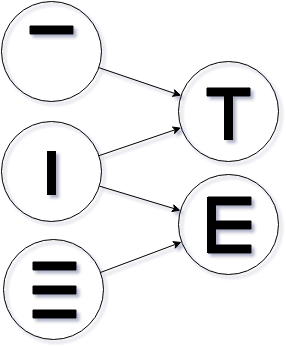
Some inputs have a common, normal, default interpretation, but can be reinterperted in different ways:

Comedy
Comedy happens when brain realizes that it recognized the wrong pattern, that predictions/expectations/explanations/assumptions that it made about a situation are (very)wrong, so it’s current interpretation of the input is destroyed, and it switches to a different(often unexpected and “crazy”) interpretation.

In practice I imagine it looking more like this:

So that a whole bunch of concepts, associations, recognized concepts gets “turned off” and switched to a completely different one.
(To keep it simple, I’m representing a whole complicated bunch of nodes that represent even more complicated bunch of neurons with just one circle)
Joke Structure
Joke consists of 2 parts: setup and punchline.
When you hear a Setup of a joke, it leads your brain to recognize a pattern, and make predictions/assumptions/expectations based on that.

Setup has 2 possible interpretations, but strongly suggests the default one.
The goal of setup is to establish a pattern, to (mis)lead a person to go down a normal, default lane of thinking.
And then punch line reveals some new information, which makes you realize that your initial recognition was very wrong, that shatters assumptions/predictions that your brain has made, brain rapidly switches to a new lane of thinking(to a different pattern), and that’s when you laugh.

Notice the element that is connected to both default and alternative interpretation. It represents the shared neurons between the 2 networks, the neurons that are responsible for recognizing either of them. It is called “connector”.

Connector is compatible with both of the interpretations, it belongs to both lanes of thinking.
For example:
Doctor’s appointment.
The doctor says “You’re gonna have to stop masturbating.”
The patient says “But why!?”
The doctor says “So I can examine you.”
The first 3 lines are the setup, they lead you to recognize a usual pattern, brain fills in the blanks, makes assumptions, and you imagine a usual doctor’s appointment, where the patient receives some bad news.
The last line is punch, which reveals new information, and forces your brain to reinterpret the setup, and imagine a completely different scenario. You realize that your default interpretation of the input was very wrong, your brain detects the mistaken pattern, and that’s when you laugh.
Notice that the setup is compatible with both interpretations, yet strongly suggests the “normal” one.
(In this case the whole setup is a connector, but to create a joke, it is not always necessary to reinterpret the whole setup, sometimes connector can be only a part of it.)
Writing a joke
When we come up with a joke, the first thing we see is a connector with 2 interpretations:
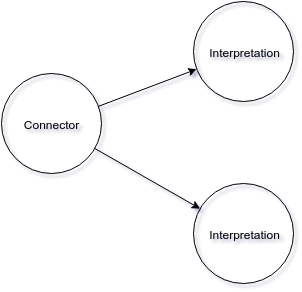
Another way to think about connector is that it is an absurd association between 2 patterns. It can be some common element or a common word that fits 2 very different patterns.
For example, one of my favorite jokes:
A family walks into a hotel, the father comes up to the front desk and says:
“I hope the porn is disabled.”
The guy at the desk replies:
“It’s just regular porn you sick fuck.”
A person who made this joke, first found a connection/association:

Then, he wrote a setup, that is compatible with both interpretations, but strongly suggests the first one, leading your brain to recognize the first pattern:

Then he wrote a punch line, that forces your brain to switch the interpretation:

Search for associations
Finding the connector that can express 2 very different patterns(be interpreted in 2 ways) is the main challenge of comedy. The process of writing comedy is the process of searching for associations, for 2 connected patterns.
You can do that in two ways:
- Find an element that lies on the intersection of 2 abstract patterns.

- Find an alternative interpretation of the the element:
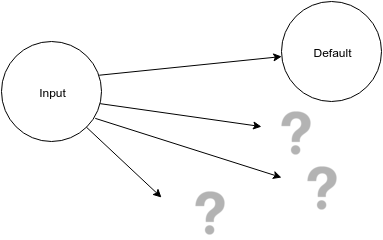
Here I want to demonstrate a simple and straightforward process for doing that(I use the 2nd way, because it’s easier to explain).
1. Scene
To begin our search we need some place to start. You can start with a random topic, but for practical purposes it can be more convenient to start with a scene — a character in a situation.
This is concrete, easy to imagine, and gives us a lot of elements to work with.
Let’s say we start with a simple random scene:
Two people playing the game of Go.
2. Elements
The first thing we need to begin our search for connections is to break down the scene into elements.
Some examples of elements are:
- Each separate word that describes the situation
- Physical things you imagine when you read a scene — objects, characters, environment
- Adjectives you would use to describe the scene and things in it.
- Expectations — what do you think will happen next
- Assumptions — why does this happen, what is going on here?
- Opinion — what is your opinion about it, what does it make you think about.

In our case that could be:
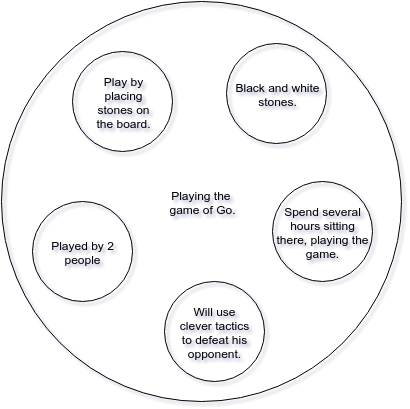
4. Drop Context, extract element.
We need associations not related to our scene(and the less related they are — the better).
So the next thing we do is select an element, and drop context — that is, we pick one of the elements from the previous scene, forget about the scene, and look at it separately, on it’s own.
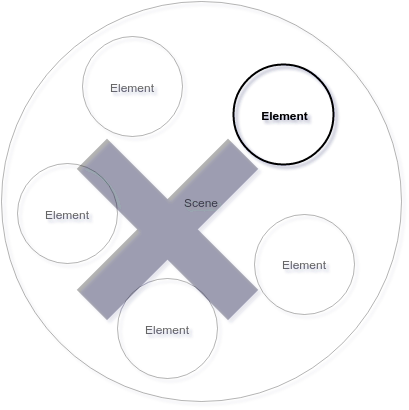
Let’s say this:

5. Look for associations.
The next step is to search for associations, find other patterns that this element belongs to(unrelated to our original scene):

In our case, for example this could be:

6. Write Setup and Punch
Finally, we have 2 separate, unrelated ideas connected by one element.

Now we can write a setup, the challenge here is to pick words that can express either interpretation, but leads your brain to think about the first one.

After that, all we need is to use the punch line to express the second interpretation, and make the switch to a second pattern:

As a result we have a joke:

Here’s a couple more examples I’ve made from the scene above:
Element: Will use clever tactics to defeat his opponent.
Association(Connector): Clever tactics — Evil Machiavellian Plotting
Setup: I’ve heard they used the game of Go to train emperors in war strategy. In go the person with smartest tactics wins.
Punch: In my opinion, the best tactic for winning Go is to frame your opponent for murder and have him executed before the game begins.Element: Play by placing stones on the board.
Association(Connector): Stones — Testicles
Setup:
- I got thrown out of the Go club last Friday.
- What happened?
- They taught me that you play by placing stones on the board, and the player who has the best shape wins.
Punch:- So?
- I placed the wrong kind of stones.
Conclusion
This framework explains the vast majority of jokes I encounter. I think it is significant, because comedy used to be a “black box” that, people claim, “can not be understood”. But now I can look at any joke, identify it’s structure, and see how all it’s parts fit together, and this allows me to reverse-engineer the thinking process of a person who made the joke.
More importantly, unlike other comedy theories, this allows me to create a process with which I can consistently generate jokes by following simple, straightforward steps. In my experience, this process works pretty well. Not all jokes made with it end up being hilarious, but they all are unmistakably jokes. And by spending enough time on search I successfully come up with some solid ideas.
In my future articles I will explain a second, more advanced process of generating jokes, provide more examples, and use this framework to explain other types of comedy(visual jokes, etc).
Disclaimers and questions
This article is my first attempt to express my ideas. I’m not a neuroscientist, and I’m sure everything is much more complicated, and my theory can be totally incomplete and mistaken, but I think it has some useful epiphanies that explain a lot of things.
I am still working on it and trying to figure it out, and now I’m looking for some feedback/ideas, I really want to talk to some smart people about the subject.
Please let me know what you think. Any criticism/questions that you have, anything that is unclear or can be better explained, any thoughts/ideas would be very valuable to me!
Questions:
- Why are there so many jokes about “taboo” subjects? It’s clearly not a necessary requirement for a good joke, yet it helps(?). Are these jokes funnier? Or easier to make? Why?
- What if comedy is not about “switching” from one interpretation to another, but about finding an unexpected connection between two abstract patterns? When I come up with a joke, I tend to laugh after finding the connector, though expressing it with well-worded setup-punch helps.
- Some jokes connect patterns that are more than one association “away” from each other. For example a joke about school shootings: “The children went to school to get books and all they got were magazines.”
Here the chain of associations is
“[School] books — magazines — [weapon]magazines.”
I want to better understand how it works and how to make those(jokes, not shootings). - More unexpected, “crazy” jokes, jokes challenging more fundamental assumptions, jokes connected by longer chain of associations, and jokes where 2 interpretations connected together “stronger”(fit with connector better) seem to be funnier. Why? Does this explain why “taboo” jokes are funnier? Could the size of the network of concepts that is being switched just be larger?
- Are there better/simple/faster, more elegant ways to write jokes? What are the other ways? What jokes can not be explained(and written) with the system I have presented? What are some counterexamples that don’t “fit” the framework?
- People who make jokes “naturally”(without the process) seem to be doing it with some quick mental operation, in one step. Is it a matter of practice? What is the best way to practice writing jokes like that? What is a way to “deformalize” this process — keep all the understanding and control, yet do it easier/faster?
- What about babies laughing at “peekaboo”? What about tickling? What about girls giggling when talking about “dirty” subjects and other forms of “social” laughter? These are not explained by my framework, and I really want to know how are they connected to “comedy” jokes.
Resources
A lot of these ideas are inspired by these wonderful books:
- “On Intelligence” by Jeff Hawkins
- “Step by Step to Stand-up Comedy” by Greg Dean
- “Serious Creativity” by Edward De Bono